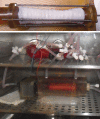Advances in tracheal reconstruction
- PMID: 25426361
- PMCID: PMC4229282
- DOI: 10.1097/GOX.0000000000000097
Advances in tracheal reconstruction
Abstract
A recent revival of global interest for reconstruction of long-segment tracheal defects, which represents one of the most interesting and complex problems in head and neck and thoracic reconstructive surgery, has been witnessed. The trachea functions as a conduit for air, and its subunits including the epithelial layer, hyaline cartilage, and segmental blood supply make it particularly challenging to reconstruct. A myriad of attempts at replacing the trachea have been described. These along with the anatomy, indications, and approaches including microsurgical tracheal reconstruction will be reviewed. Novel techniques such as tissue-engineering approaches will also be discussed. Multiple attempts at replacing the trachea with synthetic scaffolds have been met with failure. The main lesson learned from such failures is that the trachea must not be treated as a "simple tube." Understanding the anatomy, developmental biology, physiology, and diseases affecting the trachea are required for solving this problem.
Conflict of interest statement
Disclosure: The authors have no financial interest to declare in relation to the content of this article. The Article Processing Charge was paid for by the authors.
Figures



References
-
- Burdett E, Mitchell V. Anatomy of the larynx, trachea and bronchi. Anaesth Intensive Care Med. 2008;9:329–333.
-
- Farmer S, Hay D. The Airway Epithelium: Physiology, Pathophysiology, and Pharmacology. New York: M. Dekker; 1991.
-
- Weinberger SE. Principles of Pulmonary Medicine. 4th ed. Philadelphia, PA: W. B. Saunders; 2004.
Publication types
LinkOut - more resources
Full Text Sources
Other Literature Sources
Miscellaneous
